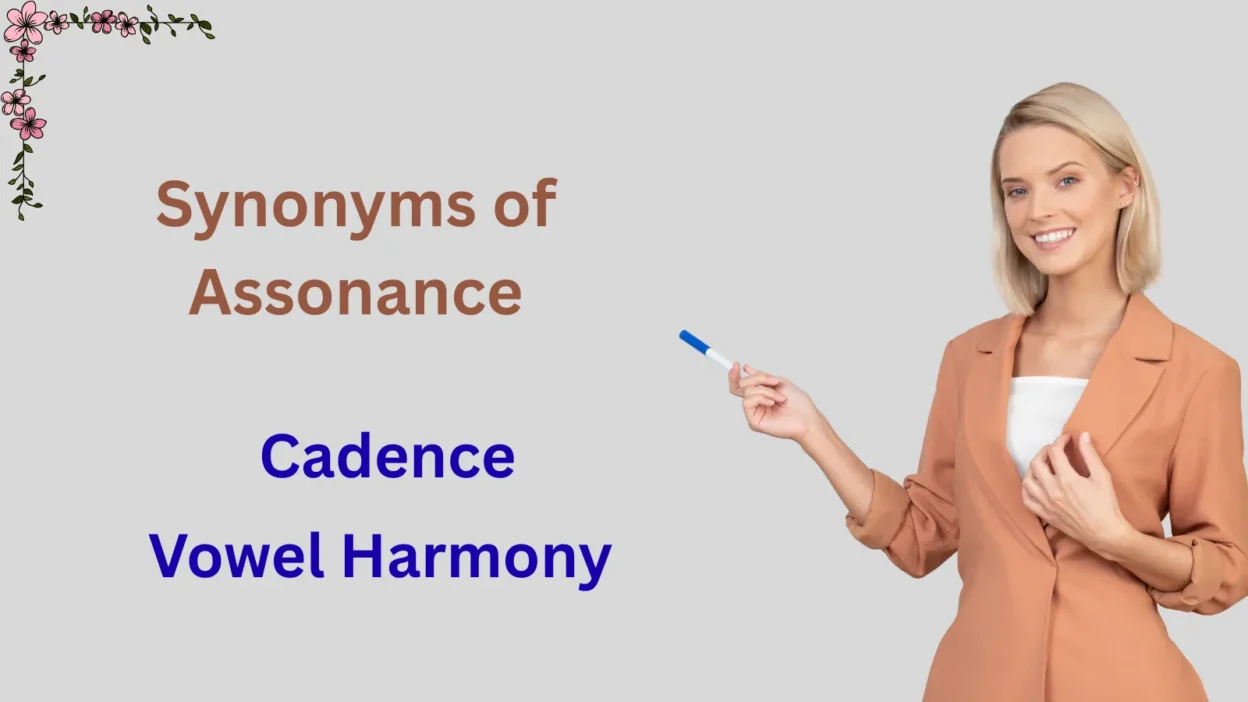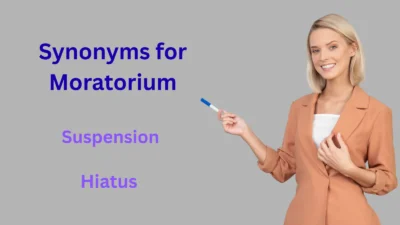Synonyms of assonance describe how repeated vowel sounds bring rhythm, flow, and beauty to language. Assonance is a literary and musical tool that gives writing a melodic quality, helping words sound more connected and emotionally alive.
Writers and poets use it to create harmony, emphasize emotion, or make phrases more memorable. For instance, in “the mellow wedding bells,” the repeating “e” sound builds musical softness and unity.
These synonyms of assonance help you describe sound effects, rhythm, and stylistic tone more precisely. Whether you’re writing a poem, song, or speech, choosing the right term gives your language texture, resonance, and expressive power.
They also help you understand how sound patterns shape emotion—turning ordinary lines into something lyrical, balanced, and unforgettable.
Understanding the Meaning of “Assonance”
Assonance means the repetition of vowel sounds within nearby words to create rhythm, melody, or emotional tone. It’s one of the key sound devices in language that gives poetry, music, and even everyday speech a lyrical flow. For example, in “Hear the mellow wedding bells,” the repeated e sound produces a smooth and musical effect that pleases the ear.
Writers use assonance to build atmosphere—soft vowel sounds can make a line feel calm or romantic, while sharp vowels can make it tense or dramatic. It’s less about perfect rhyme and more about the echo of sound that makes words resonate.
Assonance shows how the simple repetition of vowels can transform language into art—turning ordinary sentences into something memorable, musical, and emotionally rich.
Synonyms of Assonance with Usage Guidance
1. Vowel Harmony
Meaning: The repetition of vowel sounds for musical effect.
Example: “The poet relied on vowel harmony to soften the tone.”
Use When: Highlighting the technical sound aspect.
2. Vocalic Rhyme
Meaning: Rhyme created through vowel repetition rather than consonants.
Example: “The lyricist preferred vocalic rhyme over perfect rhyme.”
Use When: Academic or poetic analysis.
3. Internal Rhyme
Meaning: Rhyme within a single line of verse.
Example: “He wrote songs rich with internal rhyme and rhythm.”
Use When: Broadly discussing rhyme techniques.
4. Partial Rhyme
Meaning: A rhyme where only part of the word’s sound matches.
Example: “The use of partial rhyme added subtlety to the stanza.”
Use When: When describing near-rhymes in poetry.
5. Slant Rhyme
Meaning: Rhymes that are close but not exact.
Example: “She used slant rhyme to keep the verse unpredictable.”
Use When: Modern poetry or experimental forms.
6. Near Rhyme
Meaning: Words with similar but not identical sounds.
Example: “Near rhymes gave the song a conversational feel.”
Use When: Songwriting or casual verse.
7. Imperfect Rhyme
Meaning: Rhymes that don’t match exactly, often using assonance.
Example: “The poet’s imperfect rhymes captured raw emotion.”
Use When: Artistic contexts emphasizing imperfection.
8. Oblique Rhyme
Meaning: Rhymes that are less direct, often through vowel echoes.
Example: “Oblique rhymes added depth to the poem’s mood.”
Use When: Formal or academic analysis.
9. Half Rhyme
Meaning: Similar but not identical sound repetition.
Example: “Half rhyme helped balance the verse’s rhythm.”
Use When: Neutral synonym for partial sound similarity.
10. Echo
Meaning: The repetition of sound, often symbolic.
Example: “The echo of vowels gave the passage a haunting quality.”
Use When: Poetic or dramatic contexts.
11. Resonance
Meaning: Deep, lasting sound quality.
Example: “The resonance of vowels enriched the chant.”
Use When: Emotional or musical writing.
12. Phonetic Patterning
Meaning: Arrangement of sounds for effect.
Example: “The speech relied on phonetic patterning for flow.”
Use When: Linguistics or literary analysis.
13. Vowel Repetition
Meaning: Straightforward description of repeated vowel sounds.
Example: “The verse used vowel repetition to unify its lines.”
Use When: Clear, accessible explanation.
14. Cadence
Meaning: Rhythmic flow of sounds or words.
Example: “His voice carried a lyrical cadence.”
Use When: Musical or poetic rhythm discussions.
15. Harmony
Meaning: Pleasant combination of sounds.
Example: “Assonance created harmony in the poem’s tone.”
Use When: Emphasizing beauty and flow.
16. Dissonance
Meaning: Harsh or clashing sound repetition.
Example: “Intentional dissonance made the verse unsettling.”
Use When: When vowel repetition creates tension.
17. Alliteration
Meaning: Repetition of consonant sounds.
Example: “Though different from assonance, alliteration often pairs with it.”
Use When: Comparing sound devices.
18. Consonance
Meaning: Repetition of consonant sounds.
Example: “Consonance balanced the vowel-heavy assonance.”
Use When: Academic discussion of sound patterns.
19. Rhyming Device
Meaning: Any stylistic use of repeated sounds.
Example: “The rhyming device added rhythm to the song.”
Use When: General writing about sound in verse.
20. Meter
Meaning: Structured rhythm in poetry.
Example: “Assonance supported the poem’s meter.”
Use When: Formal literary studies.
21. Prosody
Meaning: The patterns of rhythm and sound in poetry.
Example: “Prosody relies on devices like assonance and rhyme.”
Use When: Linguistic or technical discussion.
22. Lilt
Meaning: A light, musical rhythm in speech.
Example: “The lilt of the repeated vowels charmed the listeners.”
Use When: Casual or musical settings.
23. Chime
Meaning: Pleasant repetition of sounds.
Example: “The words seemed to chime with one another.”
Use When: Evocative or descriptive contexts.
24. Sound Repetition
Meaning: Direct term for repeating sounds.
Example: “Sound repetition gave the passage a lyrical quality.”
Use When: Straightforward explanations.
25. Euphony
Meaning: Pleasant, harmonious sound.
Example: “The euphony of vowels softened the poem’s tone.”
Use When: Aesthetic emphasis in poetry.
26. Onomatophony
Meaning: Sound-based stylistic effect in words.
Example: “Onomatophony heightened the poem’s musicality.”
Use When: Technical or academic contexts.
27. Rhyme Echo
Meaning: Words that sound similar through vowel resonance.
Example: “The rhyme echo tied the lines together.”
Use When: Poetic or lyrical analysis.
28. Timbre
Meaning: The tonal quality of a sound.
Example: “The timbre of repeating vowels added warmth.”
Use When: Musical or performance writing.
29. Refrain
Meaning: Repeated line or sound pattern in poetry/song.
Example: “The refrain emphasized assonance.”
Use When: Musical or lyrical repetition.
30. Melody
Meaning: A Sequence of sounds forming beauty.
Example: “The melody of the vowels enchanted the audience.”
Use When: Describing flow and charm in sound.
Choosing the Right Synonym Based on Tone and Context
- Academic & Technical Contexts: Use prosody, phonetic patterning, vocalic rhyme, or oblique rhyme.
- Poetic & Artistic Contexts: Use lilt, chime, euphony, or harmony.
- Songwriting & Music: Use melody, refrain, cadence, or timbre.
- Simple & Clear Writing: Use vowel repetition, sound repetition, or rhyme echo.
- Experimental or Modern Writing: Use slant rhyme, near rhyme, or dissonance.
Cultural Note: In classical poetry, terms like prosody and meter are highly valued in formal analysis. In modern songwriting, slant rhyme and near rhyme are more widely accepted because they feel conversational and natural.
Conclusion :
Synonyms of Assonance reveal the richness of sound and rhythm in language. From vowel harmony and internal rhyme to euphony and melody, each term highlights a unique way that repeated sounds can shape emotion and flow.
Assonance itself is more than just a poetic device—it’s a bridge between sound and feeling. Whether you’re crafting verses, lyrics, or speeches, understanding these synonyms allows you to control tone, pace, and texture with precision. In essence, mastering assonance helps you turn simple words into music that lingers in the mind.





